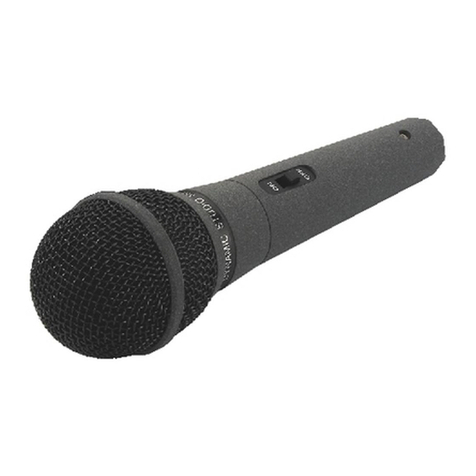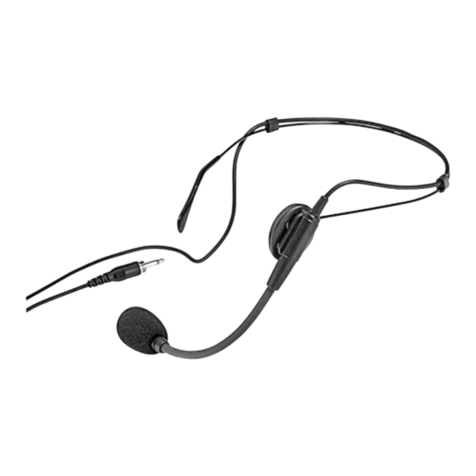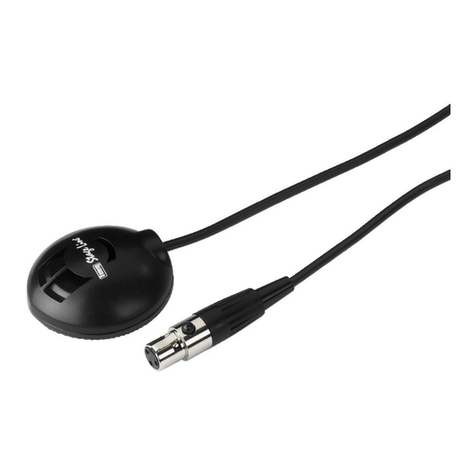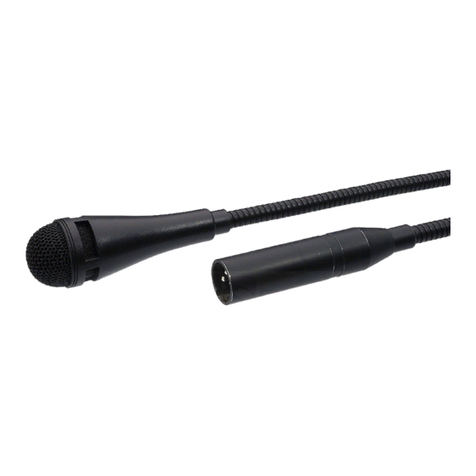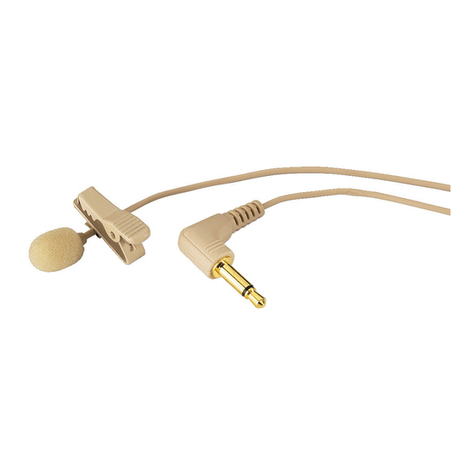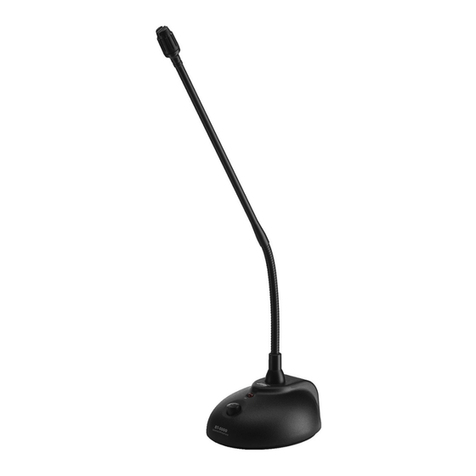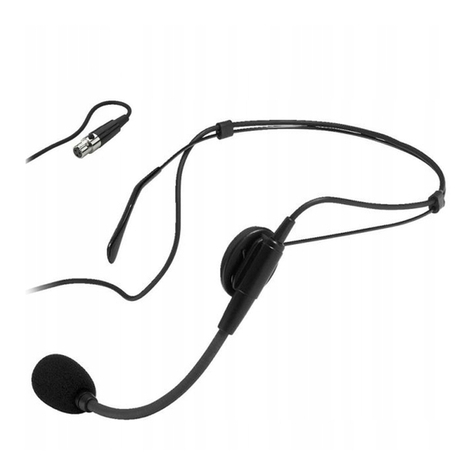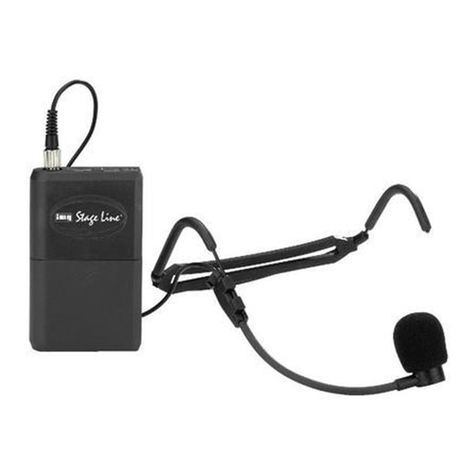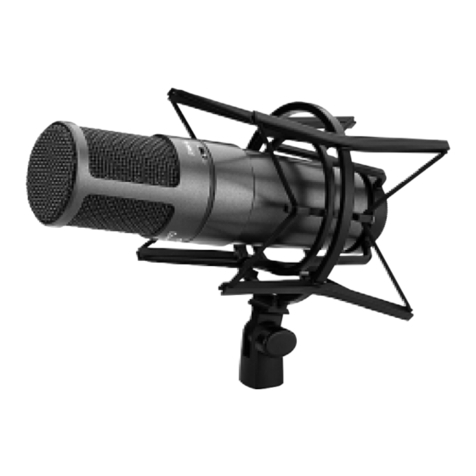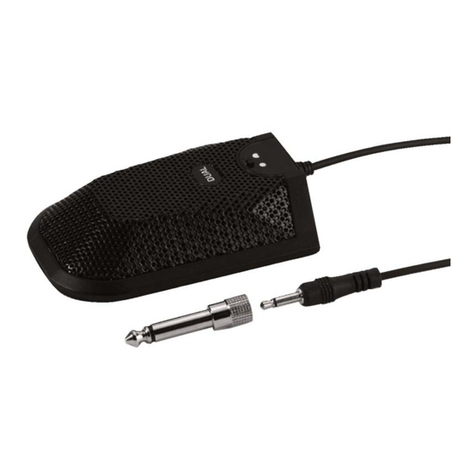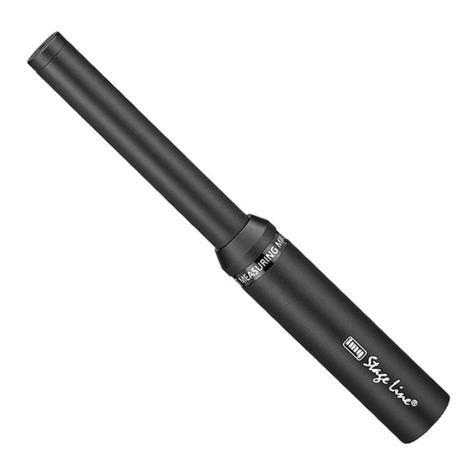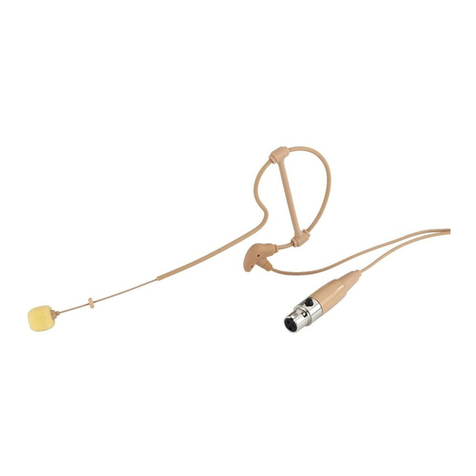Microfono archetto
Vi preghiamo di leggere attentamente le presenti
istruzioni prima dellʻuso e di conservarle per un uso
futuro.
1 Possibilità dʼimpiego
Questo microfono archetto mini, estremamente leg-
gero e non vistoso, è adatto in modo ottimale per le
applicazioni di canto e di lingua parlata che richie-
dono molta libertà di movimento. Per il funziona-
mento è richiesto un adattatore di alimentazione
(p. es. EMA-1 di “img Stage Line”) oppure, per la
trasmissione audio senza fili, un trasmettitore
tascabile (p. es. TXS-...HSE con contatto mini XLR
a 3 poli di “img Stage Line”).
2 Avvertenze importanti per lʼuso
Il microfono è conforme a tutte le direttive rilevanti
dellʼUE e pertanto porta la sigla .
GFar funzionare il microfono solo allʼinterno di lo-
cali e proteggerlo da umidità e calore (tempera-
tura dʼimpiego ammessa fra 0 e 40 °C).
HSE-50/SK
Bestellnummer 23.5910
wwwwww..iimmggssttaaggeelliinnee..ccoomm
GPer la pulizia usare solo un panno morbido,
asciutto; non impiegare in nessun caso prodotti
chimici o acqua.
GNel caso dʼuso improprio, di collegamenti sbagliati
o di riparazione non a regola dʼarte del microfono,
non si assume nessuna responsabilità per even-
tuali danni consequenziali a persone o a cose e
non si assume nessuna garanzia per il microfono.
3 Messa in funzione
Applicare sul microfono la spugna antivento in do-
tazione. Mettere lʼarchetto sullʼorecchio sinistro e
portare il microfono vicino alla bocca, in posizione
opportuna per parlare.
Collegare il microfono con lʼingresso del trasmet-
titore tascabile o dellʼadattatore di alimentazione.
Usando un adattatore di alimentazione, collegarlo
con lʼingresso microfono di un apparecchio audio.
Se si desidera eliminare il microfono defi-
nitivamente, consegnarlo per lo smalti-
mento ad unʼistituzione locale per il rici-
claggio.
4 Dati tecnici
Tipo: . . . . . . . . . . . . . . . back-elettrete
Caratteristica
direzionale: . . . . . . . . . onnidirezionale
Gamma di frequenze: . 20 – 20 000 Hz
Impedenza: . . . . . . . . . 1,5 kΩ
Sensibilità: . . . . . . . . . . 5 mV/Pa con 1 kHz
Pressione sonora max.: 110 dB
Tensione
dʼalimentazione: . . . . . 1 – 10 V
tramite adattatore di ali-
mentazione o trasmetti-
tore tascabile
Peso: . . . . . . . . . . . . . . 5 g (senza cavo)
Collegamento: . . . . . . . cavo 1,3 m con presa mini
XLR a 3 poli
Con riserva di modifiche tecniche.
1 = massa
2 = segnale audio
3 = alimentazione
Micrófono de oreja
Lea atentamente estas instrucciones de funciona-
miento antes de utilizar el micrófono y guárdelas
para usos posteriores.
1 Aplicaciones
Este micrófono de oreja miniatura, discreto y extra
ligero, es ideal para sonido vocal y aplicaciones de
habla que requieren mucha libertad de movimiento.
Para su funcionamiento también es necesario un
adaptador de alimentación (por ejemplo EMA-1 de
“img Stage Line”) o, para transmisión audio inalám-
brica, un emisor de petaca (por ejemplo TXS-…HSE
con conexión mini XLR de 3 polos de “img Stage
Line”).
2 Notas Importantes
El micrófono cumple con todas las directivas rele-
vantes de la UE y por lo tanto está marcado con el
símbolo .
GEl micrófono está adecuado para su utilización
sólo en interiores. Protéjalo de la humedad y del
calor (temperatura ambiente admisible: 0 – 40 ºC).
GUtilice sólo un paño suave y seco para la limpieza,
no utilice nunca ni productos químicos ni agua.
GNo podrá reclamarse garantía o responsabilidad
alguna por cualquier daño personal o material re-
sultante si se utiliza el micrófono para otros fines
diferentes a los originalmente concebidos, si no
se conecta adecuadamente o no se repara por
expertos.
3 Puesta en Marcha
Coloque la espuma antiviento que se entrega en el
micrófono. Ponga el enganche de oreja en la oreja
izquierda y coloque el micrófono cerca de la boca
en una posición adecuada para hablar.
Conecte el micrófono a la entrada del emisor de
petaca o del adaptador de alimentación. Si se uti-
liza un adaptador de alimentación, conéctelo a la
entrada de micro de una unidad de audio.
Si va a poner el micrófono fuera de servicio
definitivamente, llévelo a la planta de reci-
claje más cercana para que su eliminación
no sea perjudicial para el medioambiente.
4 Especificaciones
Tipo: . . . . . . . . . . . . . . . back electret
Direccionamiento: . . . . omnidireccional
Banda pasante: . . . . . . 20 – 20 000 Hz
Impedancia: . . . . . . . . . 1,5 kΩ
Sensibilidad: . . . . . . . . 5 mV/Pa a 1 kHz
Presión sonora máx.: . 110 dB
Alimentación: . . . . . . . . 1 – 10 V
a través del adaptador de
alimentación o del emisor
de petaca
Peso: . . . . . . . . . . . . . . 5 g (sin cable)
Conexión: . . . . . . . . . . cable de 1,3 m de longi-
tud con mini XLR 3 polos
Sujeto a modificaciones técnicas.
1 = masa
2 = señal audio
3 = alimentación
Mikrofon nauszny
Przed rozpoczęciem pracy proszę zapoznać się z
niniejszą instrukcją a następnie zachować ją do
wglądu.
1 Zastosowanie
Elektretowy mikrofon nauszny HSE-50/SK jest nie-
zwykle mały i lekki, co sprawia, że znajduje idealne
zastosowanie tam, gdzie konieczna jest duża swo-
boda ruchu. Mikrofon działa w połączeniu z adapte-
rem zasilania (np. EMA-1 z oferty “img Stage Line”)
lub do transmisji bezprzewodowej z nadajnikiem
kieszonkowym (np. TXS-...HSE z 3-pinowym złą-
czem mini XLR z oferty “img Stage Line”).
2 Środki bezpieczeństwa
Mikrofon spełnia wszystkie wymagania norm UE i
dlatego został oznaczony symbolem .
GUrządzenie przeznaczone jest do użytku jedynie
wewnątrz pomieszczeń. Należy chronić je przed
działaniem wilgoci oraz wysokiej temperatury
(dopuszczalna temperatura otoczenia pracy to
0 – 40 ºC).
GDo czyszczenia urządzenia należy używać su-
chej, miękkiej tkaniny. Nie stosować wody, ani
chemicznych środków czyszczących.
GProducent ani dostawca nie ponoszą odpowie-
dzialności za wynikłe szkody (uszkodzenie
sprzętu lub obrażenia użytkownika), jeśli urzą-
dzenie używano niezgodnie z przeznaczeniem,
nieprawidłowo podłączono bądź poddano nieau-
toryzowanej naprawie.
3 Przygotowanie do pracy
Na mikrofon należy założyć wiatrochron. Następnie
należy założyć mikrofon na lewe ucho oraz ustawić
mikrofon w optymalnej pozycji, blisko ust.
Należy podłączyć mikrofon do nadajnika kie-
szonkowego lub do adaptera zasilania; adapter za-
silania należy podłączyć do wejścia mikrofonowego
urządzenia audio.
Po całkowitym zakończeniu eksploatacji
urządzenie należy oddać do punktu utyli-
zacji odpadów.
4 Specyfikacja
Typ: . . . . . . . . . . . . . . . elektretowy typu „back“
Kierunkowość: . . . . . . . dookólny
Pasmo przenoszenia: . 20 – 20 000 Hz
Impedancja: . . . . . . . . . 1,5 kΩ
Czułość: . . . . . . . . . . . . 5 mV/Pa przy 1 kHz
SPL max.: . . . . . . . . . . 110 dB
Zasilanie: . . . . . . . . . . . 1 – 10 V
przez adapter zasilania
lub nadajnik kieszonkowy
Waga: . . . . . . . . . . . . . 5 g (bez kabla)
Podłączanie: . . . . . . . . kabel 1,3 m z 3-pinowym
gniazdem mini XLR
Z zastrzeżeniem możliwości zmian.
1 = masa
2 = sygnał audio
3 = zasilanie
®
MONACOR INTERNATIONAL GmbH & Co. KG
•
Zum Falsch 36
•
28307 Bremen
•
Germany
Copyright
©
by MONACOR INTERNATIONAL. All rights reserved. A-1434.99.01.04.2013
I
E
PL


